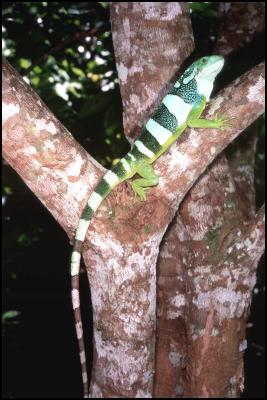Rafting Reptiles Say Hello, Hello
Rafting Reptiles Say Hello, Hello

Click to enlarge
Photo of a male Brachylophus bulabula from Ovalau Island, Fiji. Photo by Peter S Harlow.
ANU Media
Release
News from The Australian National
University
THURSDAY 18 SEPTEMBER 2008
RAFTING
REPTILES SAY HELLO, HELLO
A research team lead by a scientist from The Australian National University has discovered a new species of iguana in the central regions of Fiji. The discovery is part of a study which suggests that the ancestors of the Pacific iguanas arrived up to 13 million years ago after an 8000 kilometre rafting trip from the New World.
Detailed genetic and morphological analyses show that there are three living kinds of Brachylophus iguanas, not two as indicated in current taxonomy. Scientists named the newly revealed iguana species Brachylophus bulabula. The scientific name bulabula is a doubling of bula, the Fijian word for ‘hello,’ thus signifying an even more enthusiastic greeting.
“The iconic Fijian iguanas are famous for their beauty and also their unusual occurrence in the middle of the Pacific Ocean because all of their closest relatives are in the Americas”, said Scott Keogh, an Associate Professor at The Australian National University’s School of Botany and Zoology and lead author of the study.
The mystery of how the Pacific iguanas originally arrived has long puzzled biogeographers. Their closest relatives, found only in the New World, are separated by about 8,000 miles of ocean. The highest islands of Fiji have been above sea level for at least the last 16 million years, and the current study’s findings suggest that the Pacific iguanas, both extinct and living, were likely on the islands much of that time, following a long-distance rafting trip from the New World.
However, all of the Pacific iguanas are under threat having been adversely affected by human presence.
“Two species were eaten to extinction after people arrived nearly 3,000 years ago,” said Associate Professor Keogh. “The three living Brachylophus iguanas face threats from habitat loss and modification, and from feral cats, mongooses and goats.”
The Fiji crested iguana, Brachylophus vitiensis, is now listed as Critically Endangered on the IUCN Red List. An important study finding regarding conservation of the genetic diversity in these iguanas is that, with only one exception, every island for which there were samples was represented by at least one distinct iguana lineage.
The discovery was published this week in a special themed edition of Philosophical Transactions of the Royal Society B, which pays tribute to Charles Darwin’s contribution to the Pacific region. The other coauthors of the study are Danielle Edwards at The Australian National University, Robert Fisher at the U.S. Geological Survey in San Diego, and Peter Harlow at Macquarie University in Australia.
ENDS


 Financial Markets Authority: FMA Seeks Clarity From High Court On Use Of Eligible Investor Certificates In Wholesale Investment Sector
Financial Markets Authority: FMA Seeks Clarity From High Court On Use Of Eligible Investor Certificates In Wholesale Investment Sector Scion: Scion’s Novel Internship Model Connects Talent With Industry
Scion: Scion’s Novel Internship Model Connects Talent With Industry Financial Markets Authority: Westpac Admits To Misleading Representations That Resulted In $6.35m In Overcharges
Financial Markets Authority: Westpac Admits To Misleading Representations That Resulted In $6.35m In Overcharges Bill Bennett: Download Weekly - Review Of 2024
Bill Bennett: Download Weekly - Review Of 2024 Bill Bennett: One NZ scores worldwide first as Starlink direct-to-mobile launches
Bill Bennett: One NZ scores worldwide first as Starlink direct-to-mobile launches Hugh Grant: How To Reduce Network Bottlenecks
Hugh Grant: How To Reduce Network Bottlenecks



